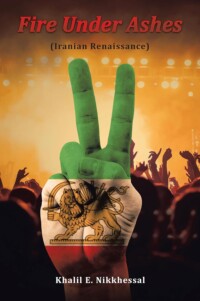Title: Fire Under the Ashes: (Iranian Renaissance)
Author: Khalil E. Nikkhessal
Publisher: Xlibris
ISBN: 9798369416600
Pages: 364
Genre: History / Non-fiction
Reviewer: Margie Przybylski
Pacific Book Review
Author Khalil E. Nikkhessal’s Fire Under the Ashes offers a comprehensive exploration of Iran’s political and social transformation, mapping out the country’s tumultuous journey from the Islamic Revolution of 1979 to the modern protests of recent years. Through a detailed historical lens, Nikkhessal delves into key events, figures, and cultural shifts that have shaped Iran, all while emphasizing the resilience of its people.
The preface sets a reflective and somewhat idealistic tone. Nikkhessal introduces themes of peace, education, and democratic values, presenting a vision of a society that thrives on legality, equality, and freedom. His metaphorical language, comparing individuals to gems that gain value through “hammering” and “polishing,” speaks to the transformative power of knowledge and discipline. This poetic outlook contrasts sharply with the struggles outlined later in the book, providing a philosophical foundation that highlights both the beauty and tragedy of the Iranian people’s aspirations. The preface effectively captures Nikkhessal’s belief in progress and transformation, setting the stage for a discussion on the conflict between tradition and modernity that defines much of Iran’s history.
In the prologue, Nikkhessal turns to the past, starting with the Arab conquest of Iran and the subsequent imposition of Islamic rule. He recounts how Persian culture, once rich and distinct, was systematically repressed by the invaders. The book details how libraries were burned, arts were criminalized, and women were relegated to subordinate roles, painting a grim picture of Iran’s cultural degradation. Nikkhessal also examines the eventual reclamation of Persian identity with the rise of figures such as Yaqoob Leith and poets such as Rumi and Saadi. This section provides a well-researched backdrop which allows readers to appreciate the roots of Iranian identity and the significance of later revolutionary movements. By situating these historical events within the broader narrative of cultural resilience, Nikkhessal highlights the enduring struggle for autonomy and expression that continues to define Iran.
Chapters in Fire Under the Ashes follow a structured approach, each focusing on pivotal moments in Iran’s modern history. From the White Revolution’s modernization attempts under Mohammad Reza Pahlavi to the harsh realities of the Islamic Republic, Nikkhessal’s coverage is exhaustive. He provides clear timelines and explains complex political events, such as the Iran-Iraq War, the hostage crisis, and various waves of protests. These historical accounts are interwoven with personal reflections and insights, giving the reader a layered understanding of the impact these events have had on ordinary Iranians.
In later chapters, Nikkhessal explores more recent events, including the “Woman, Life, Freedom” movement and the protests following the death of Mahsa Amini. The book’s most poignant moments come when he discusses the Iranian people’s persistent demands for human rights, equality, and democracy. Despite the government’s severe crackdowns, these protests embody the spirit of resistance that Nikkhessal sees as essential to Iranian identity.
Fire Under the Ashes is both informative and emotionally resonant. Nikkhessal’s ability to blend detailed historical analysis with a deeply empathetic perspective on the Iranian struggle makes this book an essential read for anyone seeking to understand Iran’s complex political landscape. Through clear, compelling prose, he illuminates the courage of the Iranian people in their fight for a just society – a fight, as he suggests, that burns like fire under the ashes, waiting for its moment to ignite once again.


